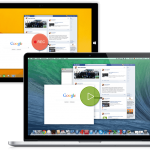level-Counterpoint: Will electronic mail Ever Disappear From The office?
Gmail announced closing month that it now has over one billion month-to-month lively customers, a benchmark it passed whereas the rest of us have been busy debating the chance of e mail’s impending death.
That isn’t to say the tool that so many of us depend on, tend religiously, and supposedly nonetheless don’t use correctly is guaranteed to persist endlessly in the workplace.
in truth, messaging apps like Slack and a slew of others are working hard to verify it doesn’t. chatting with Co.Design ultimate 12 months, the platform’s design director Brandon Velestuk mused on a future time when “I may speak to my kids about it and say, ‘neatly, there was once this factor referred to as electronic mail again in the day. I used it moderately a lot . . . ’”
For now, though, even employees who use apps like Slack nonetheless use e mail a just right deal, too. So quick company asked two leaders on the front traces of undertaking communique expertise to weigh in on e-mail’s future within the place of work. here’s what they said.
If, When, And Whom
“people have been forecasting the dying of email for the ultimate 25 years,” says John Rae-provide, lead product manager for Gmail, yet “there’s no sign that e-mail usage is abating. It’s surely altering, but in the working world, e-mail is still the baseline glue that just about incorporates everything.”
Manoj Chaudhary, CTO and VP of engineering at Loggly, a cloud-primarily based log administration platform, disagrees. “e-mail is for all sensible purposes going to start diminishing at an extraordinarily excessive fee in the next 5 to seven years,” he says. “It’ll nonetheless reside within the financial world and whatnot, but all of the early adopters and the tech-savvy companies,” in his view, are already beginning to embrace alternatives.
At difficulty, among different issues, is who electronic mail easiest serves—or even whether or not it serves some workers or industries higher than others. In Chaudhary’s view, it’s a no brainer for workers and teams for whom group messaging is solely more efficient. “in the event you go a bit of bit up the chain,” he continues, the place “the executives are involved and the turnaround time is ok to be later [and] they need to think about it and reply,” then that’s the place e mail may dangle out a while longer.
Rae-provide, then again, partly attributes e mail’s longevity to its being democratic: One platform may work better for one individual or crew than every other, but email itself is near to as universal as a digital expertise can get. “anyone can set up an e mail carrier, and anybody can send electronic mail the use of some other carrier,” he says, they usually all work with one every other beautiful seamlessly.
“These SMTP protocols that were designed a very long time in the past [Gmail has] built on high of and reinforced . . . and truly as an entire industry moved that thing ahead—but,” he’s quick to emphasize, “on the massive foundation of widely adopted requirements.”
So in order to topple electronic mail, Rae-grant believes any newcomer would need to do one higher than that whole machine, as an alternative of simply disrupting one seller or product. “remember that there used to be a time that AOL and rapid Messenger was imagined to be the thing . . . [yet] the item that has continued and grown is e-mail, as a result of it isn’t managed through any individual.”
solving individuals problems
Chaudhary believes that’s already being achieved—less by means of virtue of anyone firm’s strategy than through the moving wants and behaviors of peculiar employees. Loggly adopted HipChat, the workforce messaging app that Atlassian debuted a couple of years earlier than Slack launched, round a yr and a half of in the past. because then, Chaudhary says, the platform has simply proved the more pure fit for a lot of the day by day work that Loggly does.
“Our manufacturing techniques are getting managed thru HipChat, [including] our whole engineering, ticketing, and malicious program-tracking techniques,” Chaudhary says. e mail, he believes, can’t fit HipChat’s efficiency on the subject of the type of quick team downside-solving Loggly’s engineers need to do.
but Chaudary, who up to now labored at the workforce messaging platform Jive, says the social dimension is also an asset: “I like to have a dialog where i will see how people are feeling” via ‘like’ and different response buttons. Plus, he says, “i can see how many people have actually learn the content material, whereas in e-mail i can’t inform” (until you turn on those obnoxious learn receipts). in keeping with Chaudhary, even stand-up meetings at Loggly have migrated to HipChat.
For some, all this connectedness and immediacy represents an enormous downside. the first indicators of a “Slacklash” arrived prior this yr, with tech leaders calling out team messaging apps for buying and selling outdated distractions with new ones.
“email is non-disruptive,” Rae-supply factors out, by the use of distinction. “It’s asynchronous. if you wish to simply inform anyone about something, you send them an e mail with the expectation that they’ll get to it, just now not essentially instantly.” Obsessive e mail checking, he believes, is a problem that has much less to do with the expertise than with the individuals who use it.
“i’d say there is more noise in e mail,” counters Chaudhary, “because there’s so much you must reveal sitting in front of it, whereas the things like Jive or Yammer, you simply select the content you want to take a look at.” instead of email’s fragmentary deluge of one-on-one messages, CCs, and reply-alls, messaging apps begin from the reverse premise—of open, centralized communique—and let you whittle down from there.
what is And is not changing
What this could suggest is that the race between electronic mail and its more recent competitors isn’t a winner-take-all contest—at the least now not but. infrequently a new know-how arrives and almost straight away obliterates its predecessor, like what the iPhone did to the digital camera. other times, it doesn’t. When e-books first came on the scene, many fretted that the times of paper-based totally studying were numbered. instead (and whereas there’s no telling how long it is going to last), there may be been a division of use: nowadays, you’re extra prone to read “suburban cyborg alien-invasion romance” in your Kindle and Padma Lakshmi’s new memoir in hardcover.
email and group messaging could likewise divvy up work verbal exchange in step with use case. within the intervening time, electronic mail itself is evolving, both to sort out familiar annoyances and to line up with the changing methods people work—which incorporates the shift towards team chat. Google launched Inbox in October 2014, replete with features for filing away and “sleeping” messages. Google had long known “there have been people who have been successful at managing their e mail,” says Rae-provide. “We referred to as them ‘easy inboxers.’ They energy thru the whole thing, they would use labels and stars and set up filters . . . These are people who devour their greens each day—and then there’s the rest of us.”
Inbox features like smart Reply, which means automated responses to fashionable messages, are aimed, Rae-furnish says, at “taking the menial mental labor out of the arms of the user and hanging it in machines, the place it’s plentiful.”
but if Google wants its electronic mail solutions to free up customers’ consideration, it additionally needs to liberate their time. And so does Slack. If one in every of e mail’s virtues is its being “asynchronous,” then sensible Reply at the least makes synchronicity extra of an option. As Rae-grant places it, “the scarce resource is any person’s consideration.” whatever email’s specific fate, that’s an issue that isn’t going away every time soon.
related: 2 pointless Phrases You wish to get rid of out of your Emails
replace: An past version of this article misquoted John Rae-supply when he noted “SMTP,” or “easy mail transfer protocols,” the usual for e-mail communique, now not “SMPP,” the “quick message peer-to-peer” protocol used as an ordinary through the telecommunications business.
(35)













